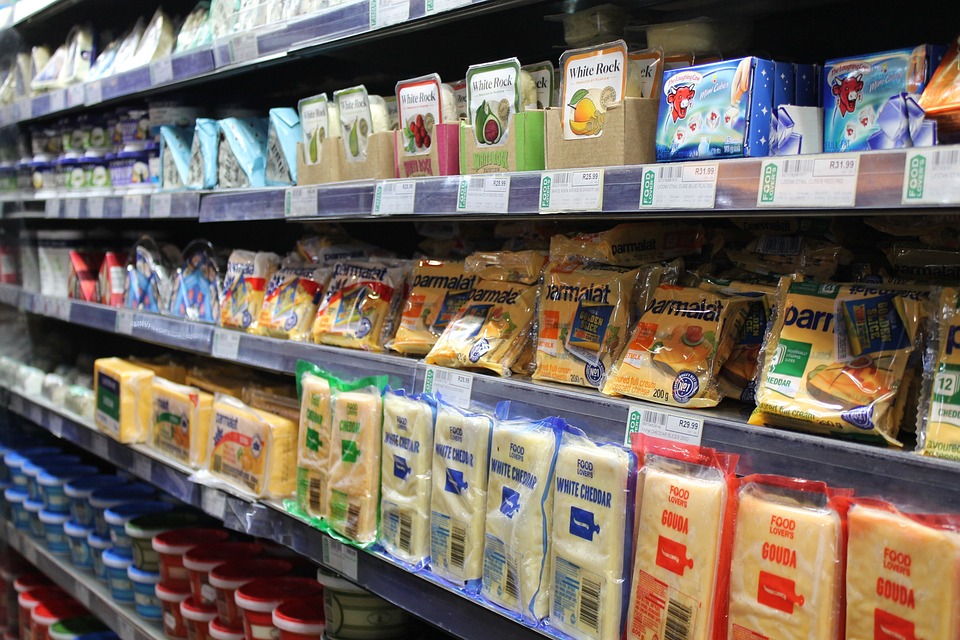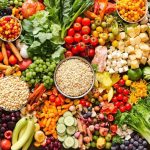
Grasping the importance of dietary rules and how to utilize DRIs when assembling your nutrient intakes will give you a greater ability to select the correct items the next time you visit the grocery store.
In 1990, the Nutrition Labeling and Education Act was passed in the United States and went into effect four years later in 1994. In Canada, mandatory labeling came into effect in 2005. Therefore, any food that is in a package available in the United States and Canada must have properly indicating nutritional information on it.
Legal requirements dictate that certain types of information must be displayed on consumer packaging. They include:
- Name and address of the manufacturer, packager, or distributor
- Statement of identity, what the product actually is
- Net contents of the package: weight, volume, measure, or numerical count
- Ingredients, listed in descending order by weight
- Nutrient information of serving size and daily values (US Food and Drug Administration. “Food Labeling & Nutrition”)
The Nutrition Facts panel reveals an abundance of information regarding the nutritional makeup of the product. The information also allows shoppers to compare products. Including the portion sizes on the label allows you to compare the amount of each nutrient per serving. It is essential to be able to decipher the contents written on food labels due to the way certain items are advertised. One potential healthy snack option to take to class could be a bag of peanuts from the grocery store. But have a look at that label. Does it contain one serving or multiple servings? Unless you have bought single-serve packages, it is likely that the bag you purchased contains a minimum of eight servings, and possibly even more.
As per the 2010 health and diet survey published by the US Food and Drug Administration, slightly more than half of individuals purchasing a product for the first time will study the food label in order to assess the fat, calorie, vitamin, and sodium content. Results from the study showed that Americans are becoming more attentive to food labels and displaying a stronger understanding of the link between nutrition and health. The FDA is emphasizing the importance of having trustworthy food labels and has begun a program that will lay out rules for the food businesses to use in order to create “front of package” labeling that will make it simpler for people in the US to pick nutritious meals.
How to Design and Create the Label
Where should the Nutrition Facts appear on food labels?
There are several ways to label packages and containers:
The Nutrition Facts information can be found on any package panel when the total area used for labeling is 40 square inches or smaller. Boxes that measure in excess of 40 square inches must show the nutrition information either on the Principal Display Panel or the info panel. The panel located directly to the right side of the PDP, when looking at the product from the vantage point of the customer, is the information panel. If the area is too small, the Nutrition Facts can be put on any part of the packaging that is easy for customers to view.
Wait. What are the PDP and the alternate PDP?
The PDP is the part of the product label that is usually what the customer will notice when they buy it. Many containers feature two or more distinct surfaces which can be used for displaying the Point of Purchase (POP). These are called “alternate PDPs”.
What is the smallest font size and what other design specifications must be followed for the nutrition labels?
The Nutrition Facts label is typically found inside a black box and shown on a white or neutral-colored background. Other hues may be employed so long as only one shade is chosen. Any items found in the vitamins and minerals category should be written in fonts sized 6 points, with a spacing of 1 point, using Helvetica Regular.
- The Nutrition Facts label uses 6-point or larger Helvetica Black and/or Helvetica Regular type. In order to fit some formats, the typography may be kerned as much as -4. Any tighter kerning will reduce legibility.
- Key nutrients and their percentage of Daily Value are set in 8-point Helvetica Black (but “%” is set in Helvetica Regular).
- Nutrition Facts is set in either Franklin Gothic Heavy or Helvetica Black to fit the width of the label flush left and flush right.
- Serving Size and Servings per container are set in 8-point Helvetica Regular with 1 point of leading.
- The table labels (for example, “Amount per Serving”) are set in 6-point Helvetica Black.
- Absolute measures of nutrient content (for example, “1g”) and nutrient subgroups are set in 8-point Helvetica Regular with 4 points of leading.
- Vitamins and minerals are set in 8-point Helvetica Regular, with 4 points of leading, separated by 10-point bullets.
If the usual Nutrition Facts label (the vertical design) won’t fit the package, what are the available options?
In situations where the primary packaging has 40 square inches of area for labeling or higher, the “side-by-side” format may be applied when the conventional Nutrition Facts panel does not take up the entire space. In this setup, the Nutrition Facts label has information related to vitamins and minerals at the bottom, situated to the right and partitioned with a line. If your label is too small to lay out all of the vitamins and minerals apart from iron, then you can have extra nutrition facts to one side, separated with a line from the other notes.
If the package does not have enough vertical space (which is approximately 3 inches), another way to display it is with a horizontal “tabular” form.
A package design firm inquired if they would be able to switch the text of the Nutrition Facts label to white letters on a dark-colored background. They argued that reverse copy if the font and colors were properly contrasted, could be just as readable as positive type.
The FDA requires that nutrition information be printed all in black ink or just one color on a white or other neutral, contrasting background if possible. The use of reverse printing or other colors is accepted, provided that the information can still be read without difficulty. If your label does not include an image, it should make up for it by enlarging the font size. It is not allowed to employ reverse printing as a form of accentuation (for instance, to just highlight certain components of the table), since it would disrupt the logical design of the label.
Could we employ a running print sticker so that the Nutrition Facts label could be cut at an unusual position, with the base of the tag near the top of the container and the peak of the label close to the bottom?
The FDA has firmly expressed that it is not permissible. Nevertheless, it is accepted to have an uninterrupted printed label that includes a single Nutrition Facts label that has not been sliced.
Is it possible to put a Nutrition Facts panel on a label and attach it to a container as if it were a sticker?
The label should remain attached to the product under the appropriate environmental conditions (eg high or low temperatures, humidity, etc). The label must be sure to remain affixed to the container during the time of purchase.
Can a Nutrition Facts label that contains two languages be used to provide nutritional information?
Yes. Nutritional details can be displayed in either of two forms: individual nutrition labels for each language or one label for all languages. If you can only select one label, the first version should be in English, with the second being a translation of all of the necessary information. It is unnecessary to duplicate numerical symbols if they are identical in both languages.
I have experimented with all the accessible types of formatting, but I cannot make them run on my label unless I make some changes. What can I do?
The FDA could allow other means of adhering to the rules or additional exceptions to address particular cases. If you need special allowances, please make your request in writing to:
Office of Nutrition, Labeling, and Dietary Supplements
HFS-800, 5100 Paint Branch Pkwy.
College Park, MD 20740
The letter should:
- Specify that you are requesting an exemption or special provision under 21 CFR 101.9(g)(9).
- Identify the particular product(s) that are the subject of the request.
- State the reason(s) why it is technologically infeasible or impracticable to adhere to the regulations for such products.
- Identify the proposed alternative procedure.
- If possible, include an example of the proposed label(s).
Can you use stickers to alter labeling?
It’s okay to make adjustments to labels as long as the end result is accurate and follows all of the required laws when being sold to customers. Stickers must not be put over any required labeling and must adhere to the instructions given for nutrition labeling.
Legal, Liability, and Exemptions
Does a company need to have a nutrition label if they have produced $51,000 worth of food with a total gross sales for all items, including food and non-food items, of $490,000?
The company does not need to comply as long as there are no statements that assert the nutritional value of the items. A firm that has a total revenue of $501,000 from all merchandise, both food and non-food, with just $49,000 coming from sales of food, is also exempt. Companies that make annual gross sales of up to $500,000 or have sales of food to consumers of up to $50,000 are not held to nutritional labeling and education requirements.
What is the exemption for small food packages?
Packages of less than 12 inches square of labeling area can include a phone number or address to get nutrition facts. An exception to not having a Nutrition Facts label is allowed as long as no statements about nutrition are made on the product label or in labeling and advertising materials and no nutritional information is provided.
Will the Food and Drug Administration (FDA) pursue legal action for minor errors if we label the nutrition information in good faith?
It is unlikely that the FDA will impose any kind of regulatory action for minor mistakes. Legal and reputation-wise, it is advisable to make sure any errors on labels are fixed at the time of the next printing.
So, what’s all the big fuss? Why all of these guidelines? What is the principal focus of the FDA when looking at my nutrition label?
The FDA is concerned about ingredients and allergens. Every component of a product must be listed on the label unless an accepted exclusion is given (for example, to secure confidential information). The order of ingredients in a recipe is given with the most prominent being listed first and the others in descending order based on the quantity used.
Any of the primary eight allergens must be clearly declared if utilized in the product. This is a list of items that includes dairy, ova, seafood, arthropod shellfish, nuts from trees, groundnuts, wheat, and beans that are part of the soy family. No exemptions.
There may be legal consequences if a company’s food items don’t meet the terms established in the Food Allergen Labeling and Consumer Protection Act (FALCPA). Potential punishments could be either civil or criminal sanctions outlined in the Federal Food, Drug, and Cosmetic Act.
My product could possibly have contact with other components, which may induce a reaction in individuals with allergies.
The FALCPA recognizes that unintentional cross-contamination may arise even in the most stringent production facilities. It is strongly suggested that you specify what ingredients that could have come into contact with your products, including the “top eight” allergen sources.
Claims on Labels
Besides requiring that nutrients and ingredients be stated on food labels, any assertions regarding the nutrient content must comply with certain stipulations. An example of this is that a producer is not permitted to state that a food item is either fat-free or has low-fat content if that is not genuinely the case. A product labeled as “low fat” means it contains three grams or less of fat, “low salt” means it has a sodium content of below 140 milligrams, and “low cholesterol” means the cholesterol content is about 20 milligrams and the saturated fat rate is two grams or less.
Health Claims
We frequently come across reports of certain vitamins or food items that are beneficial to our health or may prevent illnesses. A statement that connects a certain food to a decreased possibility of getting a sickness is referred to as a health claim. This means that the FDA must review and approve any claim that a product or item can reduce the risk of heart disease before it can appear on its packaging. Before the NLEA was passed, items that made health assertions were seen as medications instead of food. In order for a health benefit to be included on a food label, it must have scientific proof to back it up. Regulations are in place to protect consumers from any incorrect assertions that may be made by companies regarding the health benefits of their food products, as stated on their packaging. The claim is supported by scientific proof, but it cannot guarantee the cure or alleviation of the illness.
Qualified Health Claims
It is essential that health claims have strong scientific proof behind them, whereas qualified health claims are supported by evidence that is not as powerful as that of health claims. The evidence may indicate that the food or nutrient could be advantageous. The research suggests that the intake of EPA and DHA omega-3 fatty acids may be beneficial in the prevention of coronary artery disease. A single portion of [name of food] supplies [X] grams of EPA and DHA omega-3 fats.
Structure/Function Claims
Some companies purport that particular food items and components have health advantages despite there being no scientific proof for them. In these scenarios, food labels can claim that they may be advantageous to you as they may enhance your immune system. No assertions of diagnosis, remedies, therapy, or prevention of disease are to be made, and it must be specified that the statement has not been evaluated by the Food and Drug Administration.














